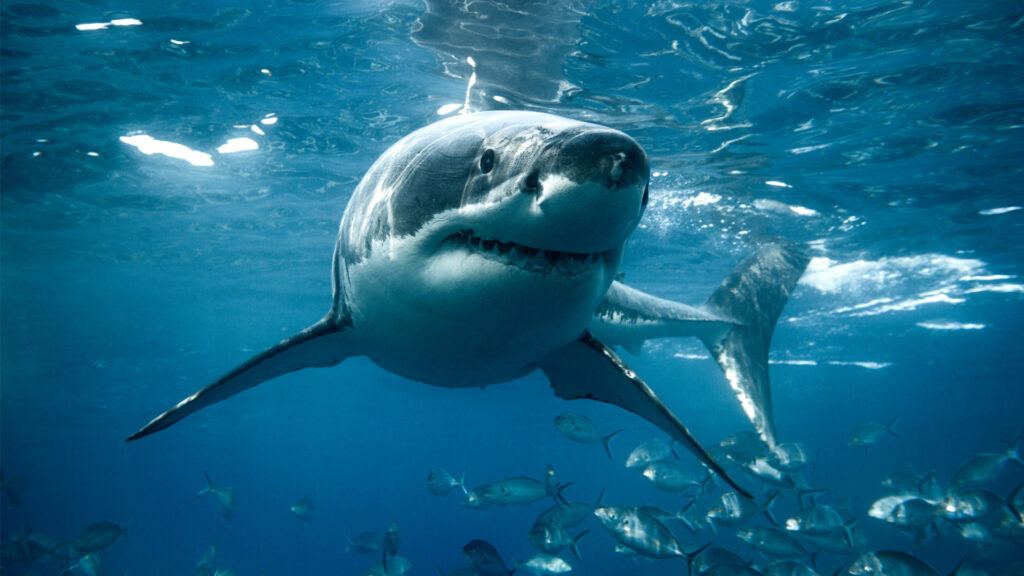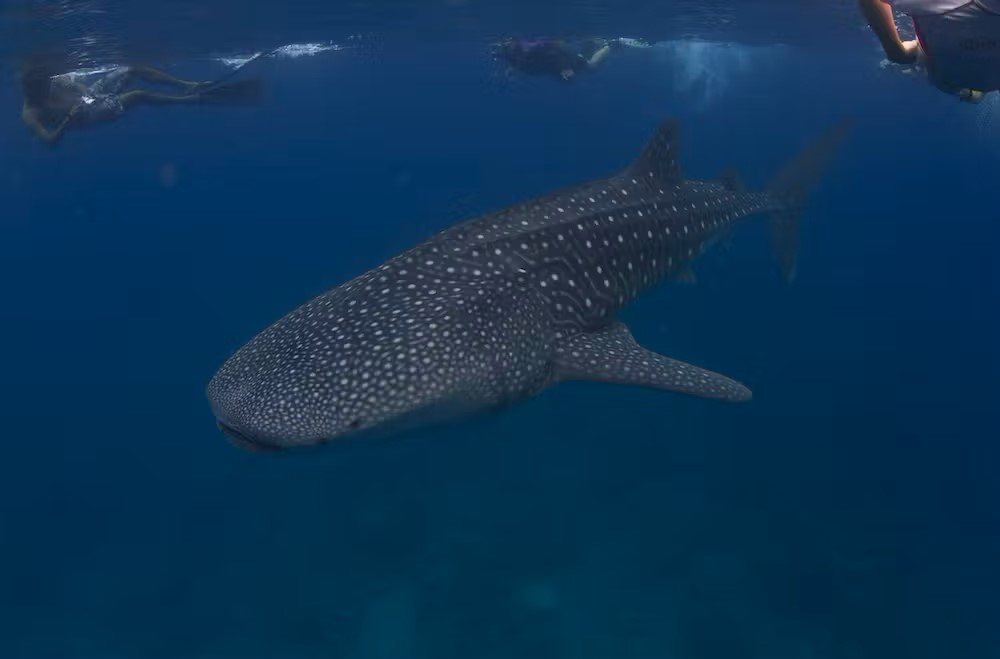By Gavin Naylor, University of Florida
Human fear of sharks has deep roots. Written works and art from the ancient world contain references to sharks preying on sailors as early as the eighth century B.C.E.
Relayed back to land, stories about shark encounters have been embellished and amplified. Together with the fact that from time to time – very rarely – sharks bite humans, people have been primed for centuries to imagine terrifying situations at sea.

In 1974, Peter Benchley’s bestselling novel “Jaws” fanned this fear into a wildfire that spread around the world. The book sold more than 5 million copies in the U.S. within a year and was quickly followed by Steven Spielberg’s 1975 movie, which became the highest-grossing film in history at that time. Virtually all audiences embraced the idea, depicted vividly in the movie and its sequels, that sharks were malevolent, vindictive creatures that prowled coastal waters seeking to feed on unsuspecting bathers.
But “Jaws” also spawned widespread interest in better understanding sharks.
Previously, shark research had largely been the esoteric domain of a handful of academic specialists. Thanks to interest sparked by “Jaws,” we now know that there are many more kinds of sharks than scientists were aware of in 1974, and that sharks do more interesting things than researchers ever anticipated. Benchley himself became an avid spokesman for shark protection and marine conservation.
In my own 30-year career studying sharks and their close relatives, skates and rays, I’ve seen attitudes evolve and interest in understanding sharks expand enormously. Here’s how things have changed.
Swimming into the spotlight
Before the mid-1970s, much of what was known about sharks came via people who went to sea. In 1958, the U.S. Navy established the International Shark Attack File – the world’s only scientifically documented, comprehensive database of all known shark attacks – to reduce wartime risks to sailors stranded at sea when their ships sank.
Today the file is managed by the Florida Museum of Natural History and the American Elasmobranch Society, a professional organization for shark researchers. It works to inform the public about shark-human interactions and ways to reduce the risk of shark bites.
In 1962, Jack Casey, a pioneer of modern shark research, initiated the Cooperative Shark Tagging Program. This initiative, which is still running today, relied on Atlantic commercial fishermen to report and return tags they found on sharks, so that government scientists could calculate how far the sharks had moved after being tagged.
After “Jaws,” shark research quickly went mainstream. The American Elasmobranch Society was founded in 1982. Graduate students lined up to study shark behavior, and the number of published shark studies sharply increased.
Field research on sharks expanded in parallel with growing interest in extreme outdoor sports like surfing, parasailing and scuba diving. Electronic tags enabled researchers to monitor sharks’ movements in real time. DNA sequencing technologies provided cost-effective ways to determine how different species were related to one another, what they were eating and how populations were structured.
This interest also had a sensational side, embodied in the Discovery Channel’s launch in 1988 of Shark Week. This annual block of programming, ostensibly designed to educate the public about shark biology and counter negative publicity about sharks, was a commercial venture that exploited the tension between people’s deep-seated fear of sharks and their yearning to understand what made these animals tick.
Shark Week featured made-for-TV stories that focused on fictional scientific research projects. It was wildly successful and remains so today, in spite of critiques from some researchers who call it a major source of misinformation about sharks and shark science.
Physical, social and genetic insights
Contrary to the long-held notion that sharks are mindless killers, they exhibit a wide range of traits and behavior. For example, the velvet belly lantern shark communicates through flashes of light from organs on the sides of its body. Female hammerhead sharks can clone perfect replicas of themselves without male sperm.

Sharks have the most sensitive electrical detectors thus far discovered in the natural world – networks of pores and nerves in their heads, known as ampullae of Lorenzini, after Italian scientist Stefano Lorenzini, who first described these features in the 17th century. Sharks use these networks to navigate in the open ocean, using Earth’s magnetic field for orientation.
Another intriguing discovery is that some shark species, including makos and blue sharks, segregate by both sex and size. Among these species, cohorts of males and females of different sizes are often found in distinct groups. This finding suggests that some sharks may have social hierarchies, like those seen in some primates and hoofed mammals.
Genetic studies have helped researchers explore questions such as why some sharks have heads shaped like hammers or shovels. They also show that sharks have the lowest mutation rate of any vertebrate animal. This is notable because mutations are the raw material for evolution: The higher the mutation rate, the better a species can adapt to environmental change.
However, sharks have been around for 400 million years and have been through some of the most extreme environmental changes on earth. It’s not known yet how they have persisted so successfully with such a low mutation rate.
The marquee species
White sharks, the focal species of “Jaws,” attract enormous public interest, although much about them is still unknown. They can live to age 70, and they routinely swim thousands of miles every year. Those in the Western North Atlantic tend to move north-south between Canada and the Gulf of Mexico; white sharks on the U.S. west coast move east-west between California and the Central Pacific.
We now know that juvenile white sharks feed almost exclusively on fishes and stingrays, and don’t start incorporating seals and other marine mammals into their diets until they are the equivalent of teenagers and have grown to about 12 feet long. Most confirmed white shark bites on humans seem to be by animals that are between 12 and 15 feet long. This supports the theory that almost all bites by white sharks on humans are cases of mistaken identity, where humans resemble the seals that sharks prey on.
Still in the water
Although “Jaws” had a widespread cultural impact, it didn’t keep surfers and bathers from enjoying the ocean.
Data from the International Shark Attack File on confirmed unprovoked bites by white sharks from the 1960s to the present day shows a continuous increase, although the number of incidents yearly is quite low. This pattern is consistent with growing numbers of people pursuing recreational activities at the coasts.
Around the world, there have been 363 confirmed, unprovoked bites by white sharks since 1960. Of these, 73 were fatal. The World Health Organization estimates that there are 236,000 deaths yearly due to drowning, which translates to around 15 million drowning deaths over the same time period.
In other words, people are roughly 200,000 times more likely to drown than to die from a white shark bite. Indeed, surfers are more likely to die in a car crash on the way to the beach than they are to be bitten by a shark.
Gavin Naylor is director of the Florida program for shark research at the University of Florida.
This article is republished from The Conversation under a Creative Commons license. Read the original article.
Sign up for The Invading Sea newsletter by visiting here. If you are interested in submitting an opinion piece to The Invading Sea, email Editor Nathan Crabbe at ncrabbe@fau.edu.
![]()



